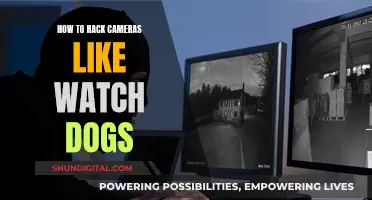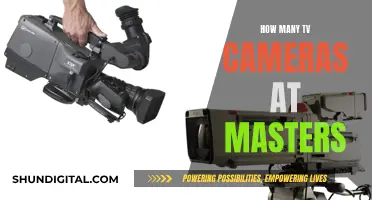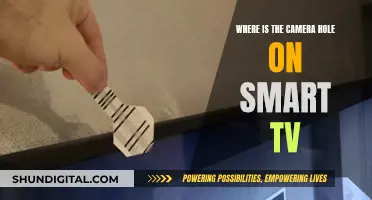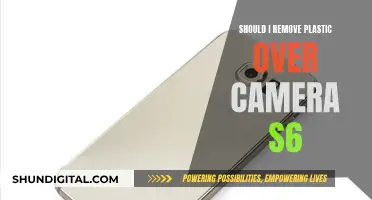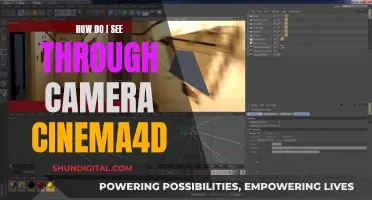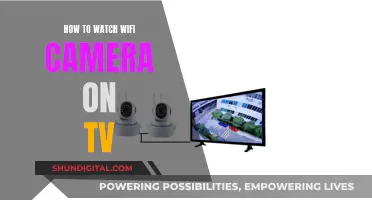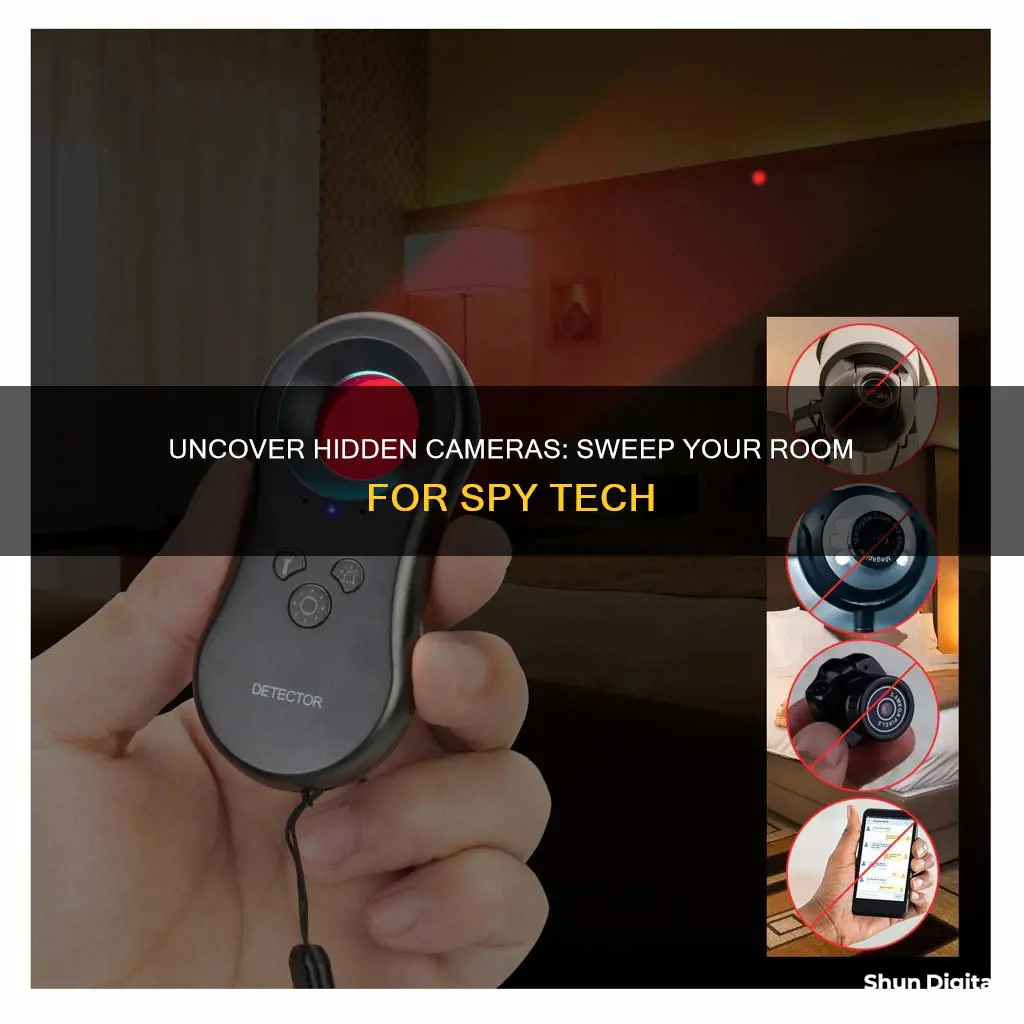
Hidden cameras are an invasion of privacy and can put your personal safety at risk. They can be hidden anywhere, from hotel rooms to Airbnbs, public restrooms, and even your own home. These devices can capture your image, activities, and private conversations without your knowledge. While it is rare, it's important to know how to check for hidden cameras to protect your privacy. Here are some ways to detect hidden cameras and ensure your privacy.
| Characteristics | Values |
|---|---|
| Use of technology | Flashlight, smartphone camera, RF detector, Wi-Fi scanner, thermal imaging camera, camera lens detector |
| Visual inspection | Check for out-of-place objects, oddities, or items that don't seem to belong; look for small lenses or pinholes; examine everyday items like clocks, smoke detectors, picture frames, lamps, flowerpots, and tissue boxes; investigate wires and electronic devices; search for hidden holes or gaps |
| Auditory inspection | Listen for faint buzzing, feedback, or other sounds that could come from a microphone |
What You'll Learn
- Manual inspection: Check common hiding spots, such as walls, outlets, and toys
- Use a flashlight: Shine a light around the room to detect reflections from camera lenses
- Investigate LED lights: Unplug suspicious lights shining in a dark room
- Look for out-of-place objects: Check decorative items that may conceal cameras
- Scrutinize wires: Inspect wires and cables that could be connected to hidden cameras

Manual inspection: Check common hiding spots, such as walls, outlets, and toys
How to Find Hidden Cameras in Common Hiding Spots
Undisclosed hidden cameras are an invasion of privacy and can put your personal safety at risk. They can be hidden anywhere, from hotel rooms to Airbnbs, offices, and even homes. While hidden cameras can serve legitimate purposes, such as alerting owners to break-ins, they should never be used to spy on, prank, or extort someone. Here are some ways to find hidden cameras in common hiding spots like walls, outlets, and toys.
Manual Inspection
During a manual hidden camera inspection, you should check common hiding spots, such as walls, outlets, and toys, for hidden camera lenses. Here are some specific tips for conducting a manual inspection:
- Use a flashlight: Carefully run a flashlight around the room at eye level, looking for tiny blue or purple reflections that could indicate a camera lens.
- Investigate LED lights: Small lights shining in a dark room could indicate a hidden camera. Unplug the device if it seems unnecessary, or look it up online to understand its purpose.
- Look for objects that don't fit in: Check for decorative items that seem out of place, such as random stuffed animals in a modern Airbnb. Inconspicuous objects like alarm clocks, smoke detectors, and picture frames can hide cameras.
- Scrutinize wires: With so many electronic devices, it's easy to overlook wires. However, these could be connected to hidden cameras that require electrical power.
- Search for holes: Cameras can be tucked away in small holes in walls, furniture, decor, or fixtures.
- Test mirrors: Place your finger against a mirror to check for hidden cameras. If there's a gap between your finger and its reflection, it's a real mirror. If they seem to touch, it could be a two-way mirror or masking a camera.
- Listen for faint sounds: Pay attention to faint buzzing, feedback, or other sounds that could indicate the presence of a microphone.
Visualizing Pallet Forks: Alternate Ways to See
You may want to see also

Use a flashlight: Shine a light around the room to detect reflections from camera lenses
Shining a light around a room is a simple but effective way to detect hidden cameras. Many modern cameras have lenses that reflect bright light, so turning off the lights and using a flashlight can help you find any hidden devices.
Here's how to do it:
- Turn off the lights in the room and draw the curtains to make the room as dark as possible.
- Shine the flashlight around the room, focusing on areas where you suspect a camera might be hidden, such as smoke detectors, alarm clocks, or power outlets.
- Look for tiny blue, purple, or red reflections that shine when hit by a ray of light. These reflections are likely from a camera lens.
- If you find a hidden camera, take pictures or videos of it for evidence.
While this method can be effective, it's important to note that it may not detect all types of cameras. Some cameras, such as older models or those that record locally, may not be found using this method. Additionally, it's important to be cautious and aware of your surroundings when searching for hidden cameras. If you are in an Airbnb or hotel, for example, be mindful of the owner's property and only perform a search in areas where you have permission to do so.
Disabling Your TV's Built-in Camera: A Step-by-Step Guide
You may want to see also

Investigate LED lights: Unplug suspicious lights shining in a dark room
Investigating LED lights is one of the methods to find hidden cameras in a room. Here are some detailed steps:
- Turn off all the lights in the room. Make sure the room is as dark as possible.
- Check whether there are blinking red or green LEDs in your room.
- Turn on a flashlight and pan it around the room to see if there is any reflective light from a lens.
- If you spot small lights shining in a dark room, it could indicate a hidden camera. To protect yourself, unplug the device if it seems unnecessary, or look up the device online to find out what the light is for.
Other methods to find hidden cameras include:
- Scanning the environment carefully: Conduct an inch-by-inch search of the room, including common hiding spots such as walls, outlets, and toys.
- Using a smartphone camera and apps: If your phone has an infrared light camera, you can use it to scan the room for small bursts of steady or flashing lights, which may indicate hidden cameras. Additionally, you can use smartphone apps that combine Bluetooth scanning and infrared detection to find unidentified devices within range.
- Checking the Wi-Fi network: Many hidden cameras connect to Wi-Fi, so you can check the connected devices on your router or use a Wi-Fi scanning app to identify any suspicious devices.
- Using a hidden camera detector: Professional RF (radio frequency) signal detectors can effectively locate spy cameras. Before using the detector, turn off and unplug all devices that send out radio signals, such as kitchen appliances, baby monitors, and routers, to ensure accurate results.
Kaltura Slideshow: How to See Your Face Camera
You may want to see also

Look for out-of-place objects: Check decorative items that may conceal cameras
When looking for cameras hidden in decorative items, it's important to be vigilant and thorough in your search. Here are some detailed steps to help you check for hidden cameras in decorative items:
Scan the Room:
Start by carefully observing the entire room. Pay attention to common and uncommon places, including walls, shelves, and decorative items such as picture frames, lamps, flower pots, or alarm clocks. Look for any oddities or items that seem out of place, such as a random stuffed animal in a modern setting.
Inspect Decorative Items:
Examine decorative items closely for any signs of tampering or hidden compartments. Be vigilant for small lenses or pinholes that could indicate the presence of a camera lens. Check items that seem strangely positioned or oriented towards private areas, such as beds or bathrooms.
Check for Out-of-Place Objects:
Be cautious with objects that seem out of place or don't match the style of the room. For example, an old-fashioned clock in a modern room or a decorative item facing a bed or bathroom. These could be covertly recording.
Investigate Wires and Electronic Devices:
Look out for unnecessary wires or devices plugged into places where they don't belong. Hidden cameras often require power, so unusual wiring or electronic devices can be a giveaway.
Search for Hidden Holes or Gaps:
Inspect decorative items, walls, and fixtures for any small holes or gaps that could house a camera lens or pinhole camera. Even the tiniest openings can be used to conceal a camera.
Use a Flashlight:
Darken the room by closing curtains and turning off the lights. Use a flashlight to scan the room, paying close attention to any reflective surfaces or glints that could indicate the presence of a camera lens.
Remember to be thorough and systematic in your search, as hidden cameras can be cleverly concealed. If you suspect the presence of hidden cameras, you may also want to consider using additional detection methods, such as smartphone apps or radio frequency detectors, to aid in your investigation.
Master Splinter Cell Blacklist: Sticky Camera Viewing Techniques
You may want to see also

Scrutinize wires: Inspect wires and cables that could be connected to hidden cameras
When looking for hidden cameras, scrutinizing wires is an important step. With so many IoT devices and home electronics, it's easy to overlook wires, but these could be connected to hidden cameras that require electrical power.
To start, look for any unusual power outlets or adapters. If you spot any, unplug them immediately.
Next, carefully inspect wires and cables, keeping an eye out for anything that looks out of place. For example, wires that are running through walls or under furniture with no obvious endpoint could be a sign of a hidden camera.
Another thing to look out for is clutter suspiciously covering a power outlet or electronic device. This could be an attempt to hide wires leading to a hidden camera.
Finally, if you suspect a hidden camera, you can use a flashlight to check for unusual reflections from objects. Turn off the lights in the room and slowly scan the area with the light. If you see any reflective lenses, this could indicate the presence of a hidden camera.
Smart TV Camera: A New Vision for Viewers
You may want to see also
Frequently asked questions
The easiest way to detect hidden cameras is to use a smartphone app that can detect infrared light. You can also use your phone's flashlight to scan the room for reflective surfaces that could be camera lenses.
Hidden cameras are often disguised as everyday items such as electrical outlets, smoke detectors, mirrors, picture frames, alarm clocks, and stuffed animals. They are usually small enough to fit in tight spaces, so be sure to check small holes in the wall and other nooks and crannies.
You can use your phone's flashlight to look for reflective surfaces that could be camera lenses. You can also try calling someone and walking around the room with your phone on speakerphone to listen for any crackling, clicking, or buzzing that could indicate the presence of a camera. Additionally, there are smartphone apps available that can scan for hidden cameras by detecting infrared light or scanning the Wi-Fi network for suspicious devices.
An RF detector is a handheld device that can be used to scan for hidden cameras by sweeping it around the room and listening for radio feedback. When the detector picks up radio frequency emissions from a camera, it will beep or make another type of noise to alert you.
If you find a hidden camera in a private space, such as your home, hotel room, or Airbnb, you should cover the camera and contact local law enforcement immediately. Do not attempt to remove or damage the camera, as it may contain fingerprints that could be useful in an investigation.


